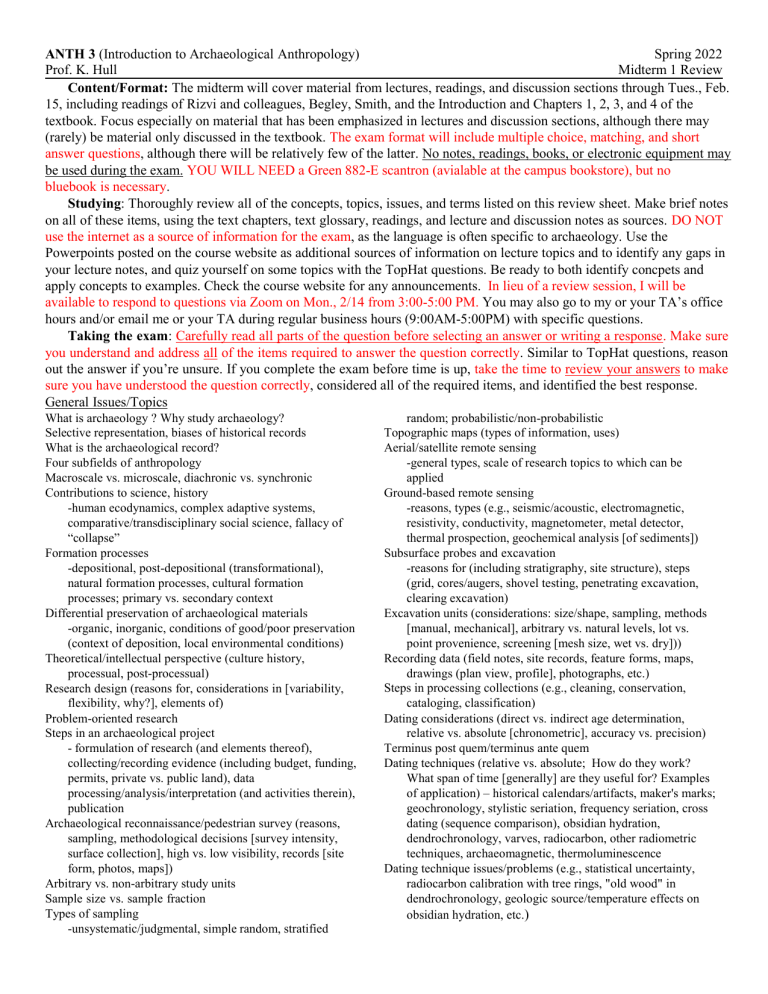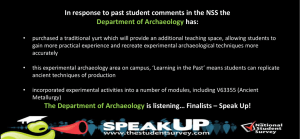
Spring 2022 ANTH 3 (Introduction to Archaeological Anthropology) Prof. K. Hull Midterm 1 Review Content/Format: The midterm will cover material from lectures, readings, and discussion sections through Tues., Feb. 15, including readings of Rizvi and colleagues, Begley, Smith, and the Introduction and Chapters 1, 2, 3, and 4 of the textbook. Focus especially on material that has been emphasized in lectures and discussion sections, although there may (rarely) be material only discussed in the textbook. The exam format will include multiple choice, matching, and short answer questions, although there will be relatively few of the latter. No notes, readings, books, or electronic equipment may be used during the exam. YOU WILL NEED a Green 882-E scantron (avialable at the campus bookstore), but no bluebook is necessary. Studying: Thoroughly review all of the concepts, topics, issues, and terms listed on this review sheet. Make brief notes on all of these items, using the text chapters, text glossary, readings, and lecture and discussion notes as sources. DO NOT use the internet as a source of information for the exam, as the language is often specific to archaeology. Use the Powerpoints posted on the course website as additional sources of information on lecture topics and to identify any gaps in your lecture notes, and quiz yourself on some topics with the TopHat questions. Be ready to both identify concpets and apply concepts to examples. Check the course website for any announcements. In lieu of a review session, I will be available to respond to questions via Zoom on Mon., 2/14 from 3:00-5:00 PM. You may also go to my or your TA’s office hours and/or email me or your TA during regular business hours (9:00AM-5:00PM) with specific questions. Taking the exam: Carefully read all parts of the question before selecting an answer or writing a response. Make sure you understand and address all of the items required to answer the question correctly. Similar to TopHat questions, reason out the answer if you’re unsure. If you complete the exam before time is up, take the time to review your answers to make sure you have understood the question correctly, considered all of the required items, and identified the best response. General Issues/Topics What is archaeology ? Why study archaeology? Selective representation, biases of historical records What is the archaeological record? Four subfields of anthropology Macroscale vs. microscale, diachronic vs. synchronic Contributions to science, history -human ecodynamics, complex adaptive systems, comparative/transdisciplinary social science, fallacy of “collapse” Formation processes -depositional, post-depositional (transformational), natural formation processes, cultural formation processes; primary vs. secondary context Differential preservation of archaeological materials -organic, inorganic, conditions of good/poor preservation (context of deposition, local environmental conditions) Theoretical/intellectual perspective (culture history, processual, post-processual) Research design (reasons for, considerations in [variability, flexibility, why?], elements of) Problem-oriented research Steps in an archaeological project - formulation of research (and elements thereof), collecting/recording evidence (including budget, funding, permits, private vs. public land), data processing/analysis/interpretation (and activities therein), publication Archaeological reconnaissance/pedestrian survey (reasons, sampling, methodological decisions [survey intensity, surface collection], high vs. low visibility, records [site form, photos, maps]) Arbitrary vs. non-arbitrary study units Sample size vs. sample fraction Types of sampling -unsystematic/judgmental, simple random, stratified random; probabilistic/non-probabilistic Topographic maps (types of information, uses) Aerial/satellite remote sensing -general types, scale of research topics to which can be applied Ground-based remote sensing -reasons, types (e.g., seismic/acoustic, electromagnetic, resistivity, conductivity, magnetometer, metal detector, thermal prospection, geochemical analysis [of sediments]) Subsurface probes and excavation -reasons for (including stratigraphy, site structure), steps (grid, cores/augers, shovel testing, penetrating excavation, clearing excavation) Excavation units (considerations: size/shape, sampling, methods [manual, mechanical], arbitrary vs. natural levels, lot vs. point provenience, screening [mesh size, wet vs. dry])) Recording data (field notes, site records, feature forms, maps, drawings (plan view, profile], photographs, etc.) Steps in processing collections (e.g., cleaning, conservation, cataloging, classification) Dating considerations (direct vs. indirect age determination, relative vs. absolute [chronometric], accuracy vs. precision) Terminus post quem/terminus ante quem Dating techniques (relative vs. absolute; How do they work? What span of time [generally] are they useful for? Examples of application) – historical calendars/artifacts, maker's marks; geochronology, stylistic seriation, frequency seriation, cross dating (sequence comparison), obsidian hydration, dendrochronology, varves, radiocarbon, other radiometric techniques, archaeomagnetic, thermoluminescence Dating technique issues/problems (e.g., statistical uncertainty, radiocarbon calibration with tree rings, "old wood" in dendrochronology, geologic source/temperature effects on obsidian hydration, etc.) Spring 2022 Midterm 1 Review ANTH 3 K. Hull History of Archaeology (you should be familiar with the basic premises, goals, assumptions of each period, the different definitions of culture for each (after 1900), and the pros and cons of each type of archaeology; make sure you understand what each concept is, not just to which period it pertains) Before 1900 (Speculative Phase/Beginnings of Modern model of culture, culture process, context, Arch) conjunctive approach, scientific method, deductive reasoning, quantitative, problem-oriented research, major developments (recognition of human antiquity, optimistic, systems theory, ecological perspectives age of the earth, evolutionary perspectives), natural (cultural ecology), techno-environmental selection, uniformitarianism, stratigraphy; unilinear explanations, evolution, cultural stages, human “progress,” threeage system Post-Processual/Interpretive Archaeologies (1980present) Culture History (1900-1960) direct historical approach, culture areas, normative critiques of processual archaeology, cognitive model concept of culture, assemblages, time-space grids, of culture (meaning), emic vs. etic, critical theory internal vs. external models of change (invention, (neo-Marxist), post-positivist, phenomenological, hermeneutic, human agency and practice, reflexive selection, drift, diffusion, migration, invasion); contributions method, multivariate explanation, individual decisionmaking Processual or “New” Archaeology (1960-1980+) problems with culture historical approach, adaptive Abbreviations (what they stand for and what these things are) BCE GPR TAQ BP GIS TPQ CE LiDAR USGS 14 C CRM SLAR Terms (in addition to those noted above) -- know what they mean, and be able to apply them correctly anaerobic datum geomorphology morphological remote sensing anoxic depositional geophysical organic research design antiquarian diachronic humanistic shovel testing period artifact diagnostic artifact hypothesis site phase assemblage ecofact inorganic stakeholder plan view association landscape synchronic post-depositional emic attributes lexicostatistics taphonomy ethnocentrism prehistory auger lithic textile ethnography profile ceramic macroscale ethnology protohistory theory classification matrix etic provenience topographic map context extrasomatic quadrat transect micromorphology contour line faunal microscale trinomial region culture feature midden reconnaissance type data universe floral People (why are they important to archaeology/why have they been mentioned in lectures or text?) Lewis Binford Ian Hodder Lewis H. Morgan William Rathje James Deetz Thomas Jefferson Sir Flinders Petrie Julian Steward Case Studies/Examples [and what they illustrate] Otzi (The Iceman) [R&B p. 70-71] Ozette site (R&B p. 60-61] Sydney Cyprus Project [R&B p. 78-79] Walter Taylor Tell Halula Project [R&B p. 98-99] Tucson Garbage Project [contribution of archaeology] Yosemite Valley depopulation [steps in research project]



